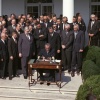There has been much talk in the last couple of months about the Religious Right's growing involvement and influence within the Republican Party. Amid all the concern about the threat to our civil liberties represented by Pat Robertson's Christian Coalition, the media has greatly neglected the emergence of a more serious menace: Capture of the Democratic Party by the Ecological Religious Left.
Vice President Al Gore has emerged as the spokesman of eco-paganism, a pantheistic prophet of global environmental catastrophe. As made clear in his book, Earth in the Balance, Gore envisions himself as the leader of an international movement to make “the rescue of the environment ... the central organizing principle for civilization.”
Gore's treatise on environmentalism became a bestseller when it first appeared and remains a standard reference work for eco-activists. Now that we are half-way through the Clinton Presidency, a re-examination of Gore's magnum opus is in order.
In Earth in the Balance, Gore calls for an “environmentalism of the spirit,” and praises primitive peoples for their reverent attitude toward the environment. Though Gore, a U.S. senator for twelve years before moving to the White House, is far removed from man in his natural state, he nonetheless hawks a quasi-religious ideology that urges man to re-establish his lost primal link with nature.
Consumed by apocalyptic visions, Gore writes of “an ecological Kristallnacht,” and declares, “the ferocity of [industrial civilization's] assault on the earth is breathtaking, and the horrific consequences are occurring so quickly as to defy our capacity to recognize them.”
These words cannot be blindly accepted. Gore's premises, like those of all environmentalists, must be challenged, subjected to rational analysis and scientific scrutiny, before his conclusion can be accepted. Thus, his repeated pronouncements of impending ecological doom beg the question: Are things really so bad? The answer: No, they are not.
Gore devotes large sections of his book to the issue of global warming. At one point, he alleges that only 2 percent of scientists disagree with him about catastrophic warming as a result of the greenhouse effect. This is demonstrably false. A February 1992 survey of climatologists--conducted by Greenpeace--found that the largest group of respondents, 47 percent of those polled, expressed serious reservations about the threat of global warming. (Keep in mind that in the mid 1970s environmentalists were alarming the world about the coming ice age!) Despite Gore's assertions, there is no consensus in the scientific community as to whether rising levels of CO2 in the atmosphere will lead to significant global temperature changes.
Nor is there any conclusive evidence proving that ozone depletion, another looming menace Gore identifies, represents a significant threat to human well-being. The various scenarios for ozone depletion predict a range of thinning from 5 to 20 percent. If this occurred, it would result in an increase in ultra-violet radiation similar to what one would encounter by moving 120 miles closer to the equator, where UV exposure tends to be greater. Such a development, while significant, would not force parents to tell their children that “they must begin to think of the sky as a threatening part of their environment,” as Gore suggests.
In any event, chloroflouro-carbons, the villainous chemicals indicated in the ozone scare, are being phased out, as per the requirements of the 1990 Montreal Protocol. The scientific consensus is that, after about the year 2000, the ozone layer will slowly start to gain in thickness and protective ability. Even Michael Oppenheimer, an atmospheric scientist with the perpetually alarmist Environmental Defense Fund, admits that, “the current and projected levels of ozone depletion do not appear to represent a catastrophe.”
Despite the lack of scientific support for his apocalyptic brand of environmentalism in Earth in the Balance, Gore proposes some dramatic and unsettling policy changes. He is convinced that society must undergo a “wrenching transformation,” if mankind is to avoid the coming environmental catastrophe. Specifically, the vice president advocates these economically devastating “solutions”: a “Global Marshall Plan,” steep taxes on carbon, more stringent vehicle fuel efficiency standards, and a phase-out of the internal combustion engine over the next twenty-five years.
The ecological doom-crier role has worked well for Gore. It helped him garner the vice-presidential nomination, and earned him a devoted following among left-leaning activists. But what has been good for Gore will not necessarily be good for America. Tomorrow's leaders are being weaned on scientifically insupportable, nursery-rhyme environmentalism. Equally frightening, today's leaders are ignoring the facts, too. Their central message, like Gore's, is that we will have to lose our liberties and empty our wallets in order to avert the latest impending apocalypse.












